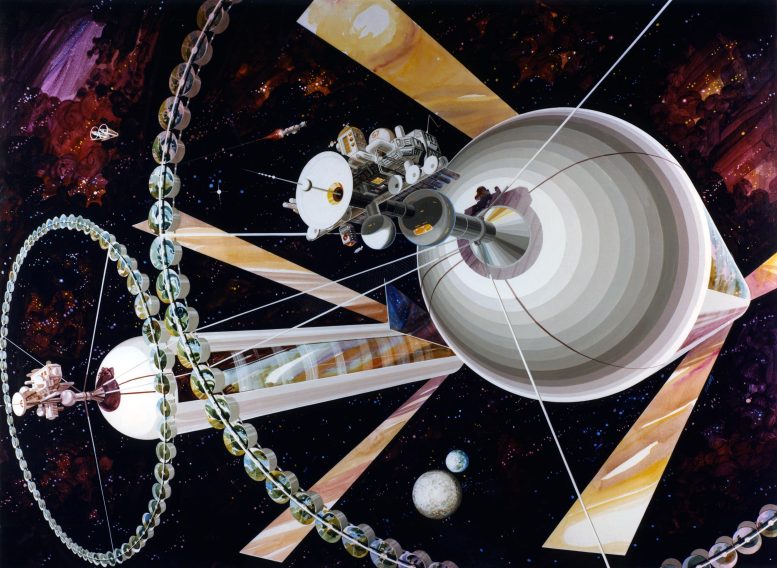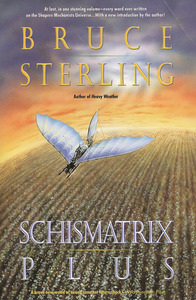You need to sign in or sign up before continuing.
Take a photo of a barcode or cover
A study of future humanity through space, this book follows the life of one man who I don't particularly care about one way or the other. While the ideas are good, the lack of sympathetic characters makes this a tough read.
medium-paced
Plot or Character Driven:
A mix
Strong character development:
Yes
Loveable characters:
No
Diverse cast of characters:
Yes
Flaws of characters a main focus:
Yes
SHORT VERSION: (not a real review)
• 1st: "Swarm" — reeeeeally liked; I can see why it's so popular and well known — reminds me of [b:Blindsight|2542808|Blindsight|Peter Watts|http://ecx.images-amazon.com/images/I/41v%2BiYMmsgL._SL75_.jpg|47428] — except that Blindsight was probably in-part inspired by this...?
• 2nd: "Spider Rose" — reminds me of that PKD story "Beyond Lies the Wub"
• aspects of the main novel (Schismatrix) cued in my mind visions of: "this is [b:Neuromancer|22328|Neuromancer (Sprawl Trilogy, #1)|William Gibson|http://photo.goodreads.com/books/1255932094s/22328.jpg|909457] on extraversion" (but mostly I think that b/c they're contemporaries?); also cued: "smatterings of this show up in [b:Accelerando|17863|Accelerando|Charles Stross|http://photo.goodreads.com/books/1255812584s/17863.jpg|930555]" (but maybe they're just sharing tropes and/or formats? arcs?)
• I think I need a re-read to unpack it and put it all back together
--
A note about this edition: it's an omnibus—and as such it contains Sterling's novel (Schismatrix) plus all the short stories in the Shaper/Mechanist milieu.
• 1st: "Swarm" — reeeeeally liked; I can see why it's so popular and well known — reminds me of [b:Blindsight|2542808|Blindsight|Peter Watts|http://ecx.images-amazon.com/images/I/41v%2BiYMmsgL._SL75_.jpg|47428] — except that Blindsight was probably in-part inspired by this...?
• 2nd: "Spider Rose" — reminds me of that PKD story "Beyond Lies the Wub"
• aspects of the main novel (Schismatrix) cued in my mind visions of: "this is [b:Neuromancer|22328|Neuromancer (Sprawl Trilogy, #1)|William Gibson|http://photo.goodreads.com/books/1255932094s/22328.jpg|909457] on extraversion" (but mostly I think that b/c they're contemporaries?); also cued: "smatterings of this show up in [b:Accelerando|17863|Accelerando|Charles Stross|http://photo.goodreads.com/books/1255812584s/17863.jpg|930555]" (but maybe they're just sharing tropes and/or formats? arcs?)
• I think I need a re-read to unpack it and put it all back together
--
A note about this edition: it's an omnibus—and as such it contains Sterling's novel (Schismatrix) plus all the short stories in the Shaper/Mechanist milieu.
challenging
dark
funny
reflective
medium-paced
Plot or Character Driven:
A mix
Strong character development:
Complicated
Diverse cast of characters:
Yes
Cyberpunk/political/space opera crossover, picaresque novel. In which Abelard Lindsey born amongst humans who have fled a dead Earth are living in artificial habitats, asteroids and moons, eventually a few of them live long enough to become Posthuman.

O’Neill cylinder-style habitat like the Mare Tranquillitatis People’s Circumlunar Zaibatsu
My yellow paged, dead tree, trade paperback version was a modest 319-pages. It had a US 1996 copyright.
Bruce Sterling is an American science fiction author. He has written more than ten novels, and numerous works of short fiction. This was the author’s third and breakthrough novel. I have read almost all the author’s books, including previously this one. However, I can’t recall the last one I read in the dim past.
I found this yellowed paperback low on a crowded shelf of a used bookstore I was prowling. I remembered reading this the first time in the static-laced, black leather, mirror shades and brushed stainless heyday of the now dead Cyberpunk genre. I barely remembered the story, but did remember it causing my eggshell, fragile mind to asplode. In that dimly lit, aisle, amongst dusty, shelves crammed with old books, its time had come again.
Note, I read the Schismatrix Plus version of the book with a 1996 copy write. This bundles the original novel of 236-pages, with the five short stories Sterling wrote in the Schismatrix Universe 11-years after the novel’s publication. The short stories are not included in this review.
TL;DR Synopsis
Abelard Lindsay, a young, dilettante of good family and Shaper-trained diplomat of a neutral circumlunar hab, falls afoul of local politics in the Shaper (psychologists and bio-engineers) and Mechanist (technocrats) factions Cold War rending the Solar System.
The Review
Schismatrix is vintage cyberpunk. It starts with the classic disorientation of the reader à la [a:William Gibson|9226|William Gibson|https://images.gr-assets.com/authors/1373826214p2/9226.jpg]. You’re thrown headlong into the deep-end of the world building pool with your clothes on, wallet and mobile still in-pocket. You need to figure out a lot of what has gone on-before by yourself—quickly. This includes puzzling out a very inventive new vocabulary. Some folks hate this. It’s likely why Cyberpunk was extirpated from main-stream science fiction? I chowed on it. I would have been a Mechanist in the novel.
Writing was good, close to excellent. The narrative was in a fractured chronological order. Some chapters followed closely, others could be decades apart. The narrative starts in lunar orbit, and reaches Jupiter’s moon Europa after about 200-years. There was a short diversion sunward to the proscribed Earth. Descriptive narration was highly imaginative, and richly detailed.
One thing I noticed with this almost 40-year old novel, was how complete a story the author told using a scant 236 pages. It’s rare to find a contemporary science fiction novel with less than 350 pages. I’ve even been exposed to several recent sf novels with 500-1000 pages by first time published authors. Forty years ago, talented authors, knew how to do more with fewer words.
Picaresque novels are written in the first person, that being the protagonist Abelard Lindsay’s POV. Contrary to the novel's type, the Lindsay character develops significantly over 200-years, abetted by rejuvenations and Mech hardware. Lindsay’s politics change several times. He goes from a young Shaper activist, to a Mechanist, to different flavors of Independent, and finally an elder, Posthumanist. In the process, he makes and leaves behind: friends, allies, enemies, wives and lovers. The elderly, cyborged and meticulously medicated senior statesman character at the end was unrecognizable as the young Shaper con-man, surviving by his wits of the story’s beginning.
Plotting. Picaresque novels are a loosely plotted series of adventures. Lindsey’s adventures advance outward from the sun, taking place on artificial habitats, asteroids, and moons. Sometimes the location is used only briefly, and others it’s for decades. Each location addresses a change in: human politics, societal evolution or Lindsey himself. A few times, it’s Lindsey affecting the political change. In others it’s Lindsey who’s changed or was changing. I noted an interesting theme on Aging as the story got long too.
There was: “Sex, drugs, and rock’n roll music, along with violence in the story.
Folks had sex. It was tastefully done, although it was of the fade-to-black type. Sexuality was part of the narrative, but it was always heterosexually oriented. The fluidity of gender or non-gender found in modern sf was almost completely absent from the story. I found this unaccountable considering the degree of societal and biological change described. Intoxicants, particularly synthetic drugs were widely in use. In general, there was a bewildering array of medicinals in-use. Old fashioned alcohol was consumed in social settings, sometimes in excess. Music was almost pervasive in social situations. In ranged from the ancient (Classical) to the undescribed then contemporary.
The body count was modest. This was despite a centuries Cold, sometimes Hot war going on. I frankly thought that there would likely have been more deaths by malice or misadventure? Vacuum Kills!. Most of the violence in space vessels or habitats was physical, or impact weapons to avoid holing the environment. The violence was moderately graphic. As the story got long the majority of it was Administrative Violence.
World building was exceptional in its breadth and detail. Several of the technologies were “sufficiently advanced technologies indistinguishable from magic”. Many elements of the world building have since become tired tropes. Others left me wondering, whey they didn’t have legs. However, there were a few anachronisms that survived. For example,
Summary
I’m a fan of old timey cyberpunk. I loved this book. It’s a story contemporary with [b:Neuromancer|6088007|Neuromancer (Sprawl, #1)|William Gibson|https://i.gr-assets.com/images/S/compressed.photo.goodreads.com/books/1554437249l/6088007._SY75_.jpg|909457], although it’s more like Vacuum Flowers (my review) in its space opera aspect.
You may have noticed I was generous with quotes in this review? The story was also very well written in that edgy and gritty style cyberpunk borrowed from hardboiled. I’m glad I Eye-read this, so I could, at points, linger over the prose.
The author packed an enormous amount of ideas into 236-pages. The story was also an embarrassment of world building riches. Just about every chapter contained one.
However, the book was an artifact of science fiction at its time (1985). Politics, technology and human limitations are not popular themes in contemporary science fiction. Whilst themes absent from this book, like gender now are. In which case, reading it felt fascinatingly, old fashioned, like viewing a Tesla coil.
Still I really liked it. It was packed full of ideas and a great piece of narrative craftsmanship. A recommended read for those interested in artifacts of a bygone science fiction genre.

O’Neill cylinder-style habitat like the Mare Tranquillitatis People’s Circumlunar Zaibatsu
My yellow paged, dead tree, trade paperback version was a modest 319-pages. It had a US 1996 copyright.
Bruce Sterling is an American science fiction author. He has written more than ten novels, and numerous works of short fiction. This was the author’s third and breakthrough novel. I have read almost all the author’s books, including previously this one. However, I can’t recall the last one I read in the dim past.
I found this yellowed paperback low on a crowded shelf of a used bookstore I was prowling. I remembered reading this the first time in the static-laced, black leather, mirror shades and brushed stainless heyday of the now dead Cyberpunk genre. I barely remembered the story, but did remember it causing my eggshell, fragile mind to asplode. In that dimly lit, aisle, amongst dusty, shelves crammed with old books, its time had come again.
Note, I read the Schismatrix Plus version of the book with a 1996 copy write. This bundles the original novel of 236-pages, with the five short stories Sterling wrote in the Schismatrix Universe 11-years after the novel’s publication. The short stories are not included in this review.
TL;DR Synopsis
Abelard Lindsay, a young, dilettante of good family and Shaper-trained diplomat of a neutral circumlunar hab, falls afoul of local politics in the Shaper (psychologists and bio-engineers) and Mechanist (technocrats) factions Cold War rending the Solar System.
”The Shapers, the Mechanists—those aren’t philosophies, they’re technologies made into politics."He sundogs it, escaping outward into the system, surviving, succeeding and failing, whilst changing vocations, identities, and locations over two centuries. In the process, he changes, whilst affecting the far-future human history in times of even greater change.
The Review
Schismatrix is vintage cyberpunk. It starts with the classic disorientation of the reader à la [a:William Gibson|9226|William Gibson|https://images.gr-assets.com/authors/1373826214p2/9226.jpg]. You’re thrown headlong into the deep-end of the world building pool with your clothes on, wallet and mobile still in-pocket. You need to figure out a lot of what has gone on-before by yourself—quickly. This includes puzzling out a very inventive new vocabulary. Some folks hate this. It’s likely why Cyberpunk was extirpated from main-stream science fiction? I chowed on it. I would have been a Mechanist in the novel.
Writing was good, close to excellent. The narrative was in a fractured chronological order. Some chapters followed closely, others could be decades apart. The narrative starts in lunar orbit, and reaches Jupiter’s moon Europa after about 200-years. There was a short diversion sunward to the proscribed Earth. Descriptive narration was highly imaginative, and richly detailed.
They had that peculiar Shaper magnetism, an acrobatic smoothness and fluidity. Yet something in the set of their shoulders, their slim, dexterous hands, kinetically displayed Constantine’s genetic heritage. They wore outlandish finery: round velvet hats, ruby earrings, and gold-laced brocade coats.Action was likewise good. Although, this was not an action-heavy novel. Dialog was terse in comparison.
”There is no war. This is evolution in action.”In addition, the writing was well-groomed. I found only one mistake. The old Timey Arbor House publishers, who published a lot of the original cyberpunk, had good editors.
One thing I noticed with this almost 40-year old novel, was how complete a story the author told using a scant 236 pages. It’s rare to find a contemporary science fiction novel with less than 350 pages. I’ve even been exposed to several recent sf novels with 500-1000 pages by first time published authors. Forty years ago, talented authors, knew how to do more with fewer words.
Picaresque novels are written in the first person, that being the protagonist Abelard Lindsay’s POV. Contrary to the novel's type, the Lindsay character develops significantly over 200-years, abetted by rejuvenations and Mech hardware. Lindsay’s politics change several times. He goes from a young Shaper activist, to a Mechanist, to different flavors of Independent, and finally an elder, Posthumanist. In the process, he makes and leaves behind: friends, allies, enemies, wives and lovers. The elderly, cyborged and meticulously medicated senior statesman character at the end was unrecognizable as the young Shaper con-man, surviving by his wits of the story’s beginning.
Plotting. Picaresque novels are a loosely plotted series of adventures. Lindsey’s adventures advance outward from the sun, taking place on artificial habitats, asteroids, and moons. Sometimes the location is used only briefly, and others it’s for decades. Each location addresses a change in: human politics, societal evolution or Lindsey himself. A few times, it’s Lindsey affecting the political change. In others it’s Lindsey who’s changed or was changing. I noted an interesting theme on Aging as the story got long too.
They believed in what they saw in him: an older man, a bit slow, perhaps, without the fire of genius others had, but generous and with the tang of mystery. With that mystery came glamour: Doctor Abelard Malvrides [Lindsey] had set his share of trends.Typically, I eschew story’s with a lot of venue changes. Here with a novel containing the theme of change, I saw the value of them. At the end, I was surprised by both a crucial reveal, and Lindsey’s last story choice.
Spoiler
Once a pícaro, always a pícaro.There was: “Sex, drugs, and rock’n roll music, along with violence in the story.
Folks had sex. It was tastefully done, although it was of the fade-to-black type. Sexuality was part of the narrative, but it was always heterosexually oriented. The fluidity of gender or non-gender found in modern sf was almost completely absent from the story. I found this unaccountable considering the degree of societal and biological change described. Intoxicants, particularly synthetic drugs were widely in use. In general, there was a bewildering array of medicinals in-use. Old fashioned alcohol was consumed in social settings, sometimes in excess. Music was almost pervasive in social situations. In ranged from the ancient (Classical) to the undescribed then contemporary.
The body count was modest. This was despite a centuries Cold, sometimes Hot war going on. I frankly thought that there would likely have been more deaths by malice or misadventure? Vacuum Kills!. Most of the violence in space vessels or habitats was physical, or impact weapons to avoid holing the environment. The violence was moderately graphic. As the story got long the majority of it was Administrative Violence.
World building was exceptional in its breadth and detail. Several of the technologies were “sufficiently advanced technologies indistinguishable from magic”. Many elements of the world building have since become tired tropes. Others left me wondering, whey they didn’t have legs. However, there were a few anachronisms that survived. For example,
An adhesive coffee table held a flip-top inhaler and a rack of cassettes.A sticky horizontal surface in low-gravity habs was a brilliant idea. Although, Sterling's future had a fondness for the now defunct tape storage. I also would have thought that something better than Velcro® would have been invented? Finely, early in the story, Lindsey sports a credit card which was really no different than the chipped card in my wallet. These artifacts existed alongside more prosaic future technologies that are still nearer now than they were in the story. (Like compact tokomaks.)
Summary
I’m a fan of old timey cyberpunk. I loved this book. It’s a story contemporary with [b:Neuromancer|6088007|Neuromancer (Sprawl, #1)|William Gibson|https://i.gr-assets.com/images/S/compressed.photo.goodreads.com/books/1554437249l/6088007._SY75_.jpg|909457], although it’s more like Vacuum Flowers (my review) in its space opera aspect.
You may have noticed I was generous with quotes in this review? The story was also very well written in that edgy and gritty style cyberpunk borrowed from hardboiled. I’m glad I Eye-read this, so I could, at points, linger over the prose.
The author packed an enormous amount of ideas into 236-pages. The story was also an embarrassment of world building riches. Just about every chapter contained one.
However, the book was an artifact of science fiction at its time (1985). Politics, technology and human limitations are not popular themes in contemporary science fiction. Whilst themes absent from this book, like gender now are. In which case, reading it felt fascinatingly, old fashioned, like viewing a Tesla coil.
Still I really liked it. It was packed full of ideas and a great piece of narrative craftsmanship. A recommended read for those interested in artifacts of a bygone science fiction genre.
Enjoyed the worlds he created a lot but found his writing on the dilpo act and statecraft a bit bizarre
My GR friend Charles accused me of "hating" this book because it's been a couple of months since I read it and I'm only now reviewing it. That is much more a consequence of life bein' life than it is of my sentiments.
I did not hate it. For this type of book to have been published in 1996, I can appreciate its significance and the import it had on the genre. I appreciate it as foundational to the genre. I can see how it shaped the hard social scifi of the next decade. I think it contemplated the paths current day humanity has before it in a prescient and honest way. That said, my money will forever be on Pandora's Star by Hamilton if I have to pick a multi generational epic based on economic differences.
CONTENT WARNING:
Things that were awesome:
-Gene splicing vs. body modification. In the 90s, cloning and genetic modification were a Big Topic. By sequencing a human's full DNA and cloning a sheep, we launched dozens of branches of science and ethics regarding the use of the human genome. It was also a time when we were considering how best to support people with limb differences, mobility issues, and body dysmorphia. As a child who grew up with this in the news, I remember, and I think this book is iconic for its contemplation of all the different outcomes over dozens of years.
-The immediacy of the writing. I always admire authors who can approach epics and maintain the same energy at each stage. You'd think someone would get tired of a character after narrating their activities for a few centuries, but Sterling was dogged.
-The internal consistency: The author made premises and built off of them. I'm not sure what else anyone can expect from SF. It was complex, nuanced, logical, and followed to its natural conclusion.
Things that did not work for me:
-Reaganism in SF. I'm no longer a child. I have seen how certain policies played out in real life and frankly, I'm over it. The 80s died. The 80s fucked me and mine hard. It was great while it lasted, but it did not last, and now in the cold light of late stage capitalism, the shine has worn off.
-Style. Again, Hamilton gets my vote for a book that survives the future. This one was an important stepping stone, but it is not the end all be all, and I'm not sure it's the best of its ilk. Perhaps fortunately, perhaps unfortunately, the generation spanning works in SF before this are fewer, and then about a decade later there were so many they become almost impossible to distinguish, so it gets compared against Foundation and then more pop culture works from my young adulthood.
So, I did like it, and find it extremely relevant to the history of SF, but I'm not sure I'd call it the future of SF either.
I did not hate it. For this type of book to have been published in 1996, I can appreciate its significance and the import it had on the genre. I appreciate it as foundational to the genre. I can see how it shaped the hard social scifi of the next decade. I think it contemplated the paths current day humanity has before it in a prescient and honest way. That said, my money will forever be on Pandora's Star by Hamilton if I have to pick a multi generational epic based on economic differences.
CONTENT WARNING:
Spoiler
casual sexism, jingoism, murder, bug things, ableismThings that were awesome:
-Gene splicing vs. body modification. In the 90s, cloning and genetic modification were a Big Topic. By sequencing a human's full DNA and cloning a sheep, we launched dozens of branches of science and ethics regarding the use of the human genome. It was also a time when we were considering how best to support people with limb differences, mobility issues, and body dysmorphia. As a child who grew up with this in the news, I remember, and I think this book is iconic for its contemplation of all the different outcomes over dozens of years.
-The immediacy of the writing. I always admire authors who can approach epics and maintain the same energy at each stage. You'd think someone would get tired of a character after narrating their activities for a few centuries, but Sterling was dogged.
-The internal consistency: The author made premises and built off of them. I'm not sure what else anyone can expect from SF. It was complex, nuanced, logical, and followed to its natural conclusion.
Things that did not work for me:
-Reaganism in SF. I'm no longer a child. I have seen how certain policies played out in real life and frankly, I'm over it. The 80s died. The 80s fucked me and mine hard. It was great while it lasted, but it did not last, and now in the cold light of late stage capitalism, the shine has worn off.
-Style. Again, Hamilton gets my vote for a book that survives the future. This one was an important stepping stone, but it is not the end all be all, and I'm not sure it's the best of its ilk. Perhaps fortunately, perhaps unfortunately, the generation spanning works in SF before this are fewer, and then about a decade later there were so many they become almost impossible to distinguish, so it gets compared against Foundation and then more pop culture works from my young adulthood.
So, I did like it, and find it extremely relevant to the history of SF, but I'm not sure I'd call it the future of SF either.
adventurous
challenging
dark
tense
slow-paced
Plot or Character Driven:
Plot
Strong character development:
No
Loveable characters:
No
Diverse cast of characters:
Yes
Flaws of characters a main focus:
Yes
Clearly one of Sterling's earlier works. Covers a lot of the same conceptual ground as Holy Fire: what will societies do to maintain control in the future, what kinds of changes will result because of vastly expanded lifespans. Definitely less fully realized. I didn't think that the short stories added much.
Oh my God I can't believe I slept on this absolute masterpiece for so long. What a stunning triumph of creative genius.





